APHIDS
These are small insects (commonly greenfly and blackfly) which suck the liquid out of tender new shoots. This weakens the blackcurrant bush. The aphids also create a sticky liquid which cover the leaves and attracts other insects and diseases. They rarely kill blackcurrant bushes but can seriously reduce the amount of fruit produced. See our detailed article on identifying and dealing with aphids here. A close-up picture of an aphid attack on a blackcurrant leaf can be seen below, click it to enlarge and see the full horror!
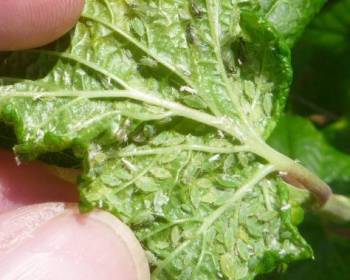
Greenfly on a blackcurrant leaf
One particular aphid can cause red blisters and marks on the surface of the leaves on all the currant bushes. It’s called the Currant Blister Aphid (Cryptomyzus ribis), see the picture below. This particular aphid tend to restrict itself only some of the leaves and although the effect looks dramatic it rarely affects the health of the plants. We simply ignore them. If you want treat it then do as described for aphids above.
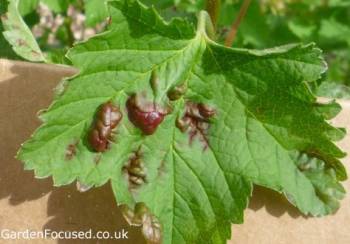
![]()
Currant Blister Aphid
Red areas on currant bush leaves
Aphids, including the Currant Blister Aphid, are first seen on currant bushes from late April to mid May depending on the climate in your area. If you do intend to spray them, do it at the very first sign of damage for maximum effect.
BIG BUD MITE
Big bud mite almost exclusively affects blackcurrant bushes. In late winter, January and February time, when the buds would normally begin to form, they do so but are much larger than normal. Affected buds either fall off or produce distorted growth which fails to produce fruit.
There is no cure for big bud mite, chemical or otherwise so your best course of action is to let the plants grow throughout the season, harvest whatever fruit is produced (it is safe to eat) then dig up and burn the plant. Replace with another plant, the variety Ben Hope has good resistance to big bud mite.
REVERSION DISEASE
Reversion Disease affect blackcurrant bushes almost exclusively. It is a virus which cannot be treated and affected plants should be dug up and burnt. The variety Ben Gairn has been shown to have some resistance to Reversion Disease.
In almost all cases it follows an infection of Big Bud Mite (see above). Reversion Disease will cause the yield of your blackcurrant bush to reduce significantly to almost nothing after three years. Another sign of Reversion Disease are flowers which are malformed.
MILDEW
Mildew often affects blackcurrant bushes and it is normally preventable. The signs are a greyish powder which can appear on the fruit, leaves and in bad cases on the stem. It is unlikely to kill the bush but it will weaken it and make it more prone to other diseases. For a full description of the symptoms and treatments for Powdery mildew, click here.
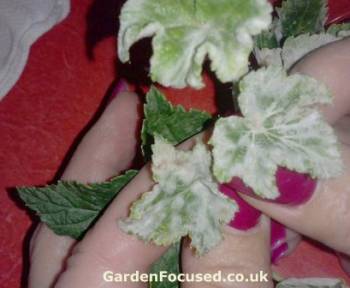
There are chemical sprays available to help kill mildew although prevention is much better than cure. Older varieties of blackcurrants are far more susceptible to mildew so avoid growing those. The “Ben” varieties (with the exception of Ben Lomond) of blackcurrants are all resistant in some degree to mildew. The new variety (to the UK) Titania also shows significant resistance to mildew.
Pruning methods can also significantly reduce the risk of being affected by mildew. See our article of pruning blackcurrants here. If your blackcurrants are susceptible to mildew pay particular attention to keeping the central part of the bush free from congestion. Also take care to remove all crossing and touching branches. When they rub together they can open up the bark letting in infections.
FRIUTS FALL OFF BEFORE THEY ARE RIPE
The symptoms are that blackcurrant bushes form green currants normally but around mid May to mid June they fall off before they are ripe. This can be due to several causes and it is known as “run-off“. By far the most common cause is adverse weather conditions especially cold weather. Other causes can be lack of water, pests and diseases, particularly botrytis and mildew. It can occur in one year and then never appear again or can occur in several years depending on the cause.
Older varieties of blackcurrants are particularly prone to run-off and often the only solution is to plant one of the newer varieties which are more resistant. Our suggestion for a variety which rarely suffers from run-off is Ben Sarek.
LEAVES WILT AND BLACKCURRANT PLANTS DIE
If the leaves on a blackcurrant bush wilt and die, but at the same time you are sure there is no shortage of water, then the conclusion must be that, for some reason or other, the roots are not able to take up moisture and nutrients. The most common cause of this in the UK is the vine weevil. In its most damaging stage of life it eats the roots of blackcurrant bushes both in pots and the open ground. To find out how to specifically identify this pest and what can be done to eradicate it click here for our in depth page on vine weevils.
WOOLLY (VINE) SCALE INSECT
The symptoms are small patches of white stuff on the stems of blackcurrant bushes. They often appear on slightly weaker parts of the bark where leaves or small stems have broken off. If you prune late in the year they will also be attracted to the point at which a stem has been pruned. The picture below shows just that happening although they can just as easily appear anywhere on stems and branches.
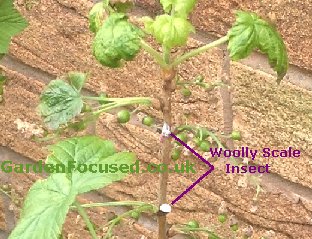
Woolly Scale Insect (click to enlarge)
The technical name for this insect is Pulvinaria vitis. At the centre, underneath the white substance you will find a female scale insect and she has laid eggs and then created the white covering to protect the eggs. They can vary in appearance, shape and size depending on the conditions. A few of them don’t do much damage but if left they will breed and can then become a problem.
The white coating protects them from insecticides which are of little use because they just run off. If you can get the timing just correct, the time to spray with an insecticide is when the eggs hatch and the young scale insects begin moving about to a new part of the plant. In most cases, this window of opportunity is too small to be of use. The only way to get rid of them is either to squash the white blobs with your fingers (killing the eggs inside) or to use a toothbrush or similar to do the same job.
OTHER SCALE INSECTS
There are many forms of scale insects which attack a variety of plants and blackcurrants are often one of their victims. The picture below shows just how scary looking this pest is but, although serious if left to its own devices, it is not impossible to control. At maturity they look like pea-sized growths which are purple-brown on stems and young branches.
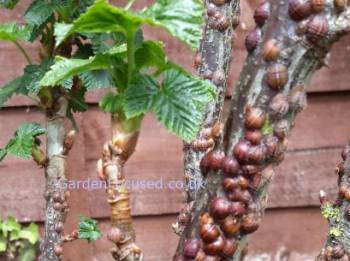
Picture of scale insects on a blackcurrant bush
(picture courtesy of Margaret L.)
First, exactly what is it? What you see in the picture above is a scale insect which feeds on the sap of a twig, branch or leaf. Their life cycle begins when the scales overwinter and then lay eggs around May time – 200 or so eggs which are beneath the parents body. In May to mid July the eggs hatch and crawl away to new parts of the tree. This is the stage at which pesticides can be effective, when the insects are moving about. When the insects find a suitable position they clamp their jaws onto the bark of tree and begin to feed on the sap of the tree without moving again.
If you can identify the period in May /June when the young scale insects are on the move spraying with an insecticide will kill them. Ask at your garden centre for an appropriate spray. In general though, sprays suitable for killing aphids will also kill moving scale insects.
If you miss this stage of their lifecycle then a plant oil winter wash treatment (again ask at your local garden centre) in December to January will effectively suffocate many of the overwintering bugs.
The easiest method, if your tree is a manageable size, is to manually remove the scale insects around May when they are clearly visible but have not yet hatched their eggs. If you are squeamish about removing them with your fingers use a toothbrush and some diluted washing up liquid to brush them off. A gentle spray after with a hose should then remove all traces of them.
CORAL SPOT
This is a fungal infection which causes yellow / orange / coral spots on the stems of blackcurrant bushes (and many other plants with woody stems such as red currants). At different stages of the disease the appearance changes slightly.
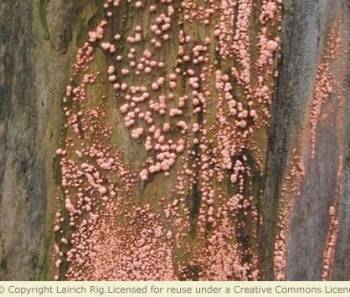
Picture of Coral Spot on a blackcurrant bush
The fungus initially attacks dead wood which, in the case of blackcurrants, is normally caused by faulty pruning techniques. It then spreads to live wood and affects the health of the bush. Small, deformed leaves are the secondary sign followed by stems which die back. In the end the plant will die if not treated.

Another picture of Coral Spot
To halt the progress of the fungus the minimum which should be done is to prune out all affected wood. Do this 15cm into good, healthy looking wood. Our personal recommendation would be to prune the entire plant back so that only 15cm remains above ground level.
This is harsh treatment and the bush is unlikely to produce fruit for two years. However it has the best chance of eradicating the fungus completely. If the bush is ten or more years old it is best to remove entirely and replace with a new plant.
To avoid this fungus follow our pruning instructions which can be found here. Use sharp implements to prune and make the cuts as clean as possible.
BLACKCURRANT SAWFLY
The key sign of this pest are simple to identify, the leaves are reduced to skeleton and look like lace. The sawfly has five distinct stages to its life cycle and the damage is done in the fourth cycle, when the pest is a caterpillar. They eat the soft parts of the leaves leaving the veins completely alone. The fruit is also untouched.

Picture courtesy of reader Peter L.
This pest should be treated in exactly the same manner as raspberry sawfly as described here.
STEMS ARE HOLLOW / HAVE BLACK CENTRES
Some observant people notice, when pruning their blackcurrant bushes, that some of the stems are either hollow or have black / brown marks in the centre. See the two pictures below which clearly show what the problem is.
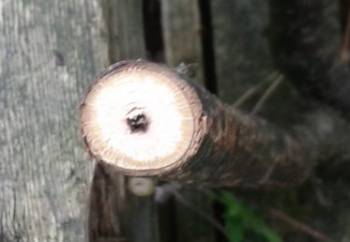
![]()
Blackcurrant stem with black ring in the centre
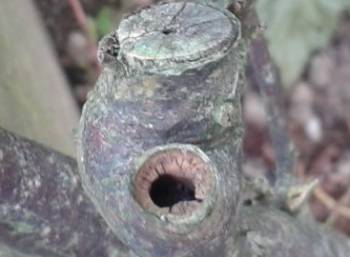
![]()
Blackcurrant stem hollowed out in the centre
Both of these are simply stems which are past their best. The black centre in the stem occurs first and if the stem is not pruned it later becomes hollow in the centre. Neither of these stems will produce a crop of blackcurrants so the solution is to prune them away as close to the base of the plant as possible without damaging the plant.
Regular pruning as recommended here will ensure that similar branches are pruned away before they get to this stage, ensuring the maximum amount of fruit is produced each year.
CURRANT BORER
The larvae of the Currant Clearwing Moth is commonly called the Currant Borer. It’s not a common pest in the UK but does occasionally strike. The moths don’t really look like your average moth. The bodies are slim and black with two wings and two feelers clearly visible from the front of the head. Males have four yellow bands around their body, females have three.
The larvae, which do the damage are 15 to 18mm long and a cream body. Because they are concealed inside the stems they are often not noticed and cannot be treated with pesticides. An understanding of the Currant Clearwing Moth may help in preventing too much damage.
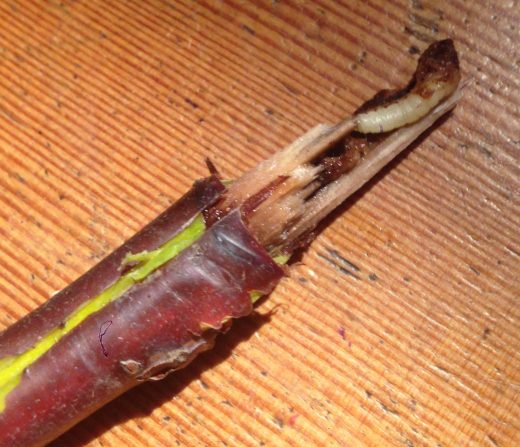
Larvae of Currant Clearwing Moth
Picture courtesy of Aubin van Berckel
APRIL TO MAY
The moths will be seen flying around the currant bushes often resting on the leaves. They lay tiny single eggs in the V between new shoots or buds. The eggs hatch after a week or two and the larvae, which are small at this stage, eat their way into the centre of a stem.
MAY TO APRIL
The larvae spend all this time feeding on the centre part of the stems and go into hibernation in winter.
APRIL TO MAY
The warmer weather re-invigorates the larvae who eat into the outer wood of the stem leaving a thin outer layer. They spin a cocoon which in a week or so pupates and then eats its way through the remaining thin bark layer and emerges as the moth. The skin of the pupa remains at the exit hole from the bark.
After reading through the lifecycle above you’ll now understand how difficult it is to treat this pest. It is possible to spray pesticide on the leaves in April to May time in an attempt to kill the moths but there is no research to understand if this is effective.
The best course of action is to prune the affected bushes to 15cm / 6in above ground level in December time and burn the prunings. This will result in a very low crop the next year but in later years the plant will fully recover.
COMMENTS / QUESTIONS LEFT BY OUR READERS
| Date: 28 August 2015 | From: Katherine |
| The leaves on my blackcurrant bushes have a lace effect but I am not sure how to deal with them. Cannot see any bugs etc. which could be responsible. Help
ANSWER: Almost certainly that’s sawfly damage, some of them go for blackcurrant leaves. They should be treated exactly the same as raspberry sawfly, our section on that can be found here. It’s not unusual that you can’t see them, this is often the case but they are there! See the picture in our main article above to confirm the damage. |
|
| Date: 23 July 2015 | From: Jill Maltby |
| My blackurrant has coral coloured spots on the stem and then the whole branch begins to die with the leaf becoming very small, the fruit stopping growth and then the stem dies. It killed one bush last year now my other healthy bush has developed the same problem, not effecting the red currants.
ANSWER: That sounds very much like Coral Spot. We have added a new section above about this fungal infection which can be found here. |
|
| Date: 14 July 2015 | From: Geoffrey Evans |
| In have had an old black currant bush that gives good yields although less and with smaller fruits as the years go by. Do black current bushes have a life span or, if properly cared for, do they go on forever?
ANSWER: Blackcurrant bushes live for about 50 years but fruit production gradually reduces after 10 to 15 years. |
|
| Date: 7 July 2015 | From: Several people |
| QUESTION: The currants on my blackcurrant bush are shriveling and turning orange / yellow before they they ripen. (This is a summary of several similar questions). A typical picture of the problem has been sent in by Sandra:
ANSWER: At the moment I have no definite answer to this question although I am actively investigating and will update this page when I find out more. I am aware that this problem is affecting many people. First thoughts are that this is a type of run-off because that is the prime cause of blackcurrants falling off before they reach maturity. Does anyone have any ideas? |
|
| Date: 22 June 2015 | From: Dave |
| On the tip of every stem of my Black Current Bush the leaves are folding in on themselves into a sort of ball and inside they are full of what looks like minute black eggs or bugs, can anyone tell me what they are and what should I do?
ANSWER: Aphids are attacking the tender ends of the leaves. They can be white, black. grey. See our aphid page here. |
|
| Date: 7 June 2015 | From: Andrew Dobson |
| My blackcurrant bush has a sticky substance on the leaves, what can this be?
ANSWER: Almost certainly it’s aphids. They drip a sweet liquid which then attracts moulds so read the paragraph on aphids above above for what to do. When looking for aphids, locate the leaves with the sticky coating on the leaves and examine the leaves immediately above for signs of the aphids. The leaf with the sticky coating may not yet have aphids on it. |
|
| Date: 11 May 2015 | From: Margaret Leverett |
| The stems of blackcurrant bushes are covered with these small red swellings or warts. These don’t look like insects, but they come off the bark quite easily. The blackcurrants are about 3 years old. They are very slow in coming out this year, but I thought it was because we had moved them over the winter. Do we need to get rid of the bushes? Both bushes are affected. There is a photo attached so you can see. I looked on your Web site, but couldn’t diagnose what the problem was.
ANSWER: That’s scale insects. They seem to be more common nowadays so I have added a new section above describing what they are and how to deal with them. See here. |
|
| Date: 31 August 2014 | From: Jim Devine |
| I had a pinky variegated colouring on my black currant and the leaves crinkles. The leaves didn’t die but there was little crop. The other bushes were ok. Can you help or advise please. Can send a photo if you require one. Thanks
ANSWER: I can’t identify the pest from the description you gave, send a picture via our contact us email and I’ll do my best. It does however sound very much like Currant Blister Aphid, see above for more details. |
|
| Date: 01 August 2014 | From: Hemu |
| My blackcurrants leaves got eaten by bugs. They are dark brown with white dots around body. Just saw them few minutes ago. What is it, and where it came from and how to treat those bugs? Thank you.
ANSWER: I can’t identify the pest from the description you gave, send a picture via our contact us email and I’ll do my best. Does anyone else have any ideas? |
|
| Date: 30 July 2014 | From: Eileen Donovan |
| This year – earlier and recently – I have had three youngish bushes suddenly die off – their leaves died as if they had run out of water. No sign of pests. They were OK for water. What killed them, please, and do I need to take precautions when replanting? Thanks for your help.
ANSWER: Eileen, I have added a new section above about what may be the cause of your problem. Click here to go there now. |
|
| Date: 13 July 2014 | From: Becca |
| My blackcurrants have been suffering from run-off for the last 3 years. I don’t recall what varietal they are, but it’s not one of the RHS recommended ones. We live in Seattle, which has very dry spring/summer weather, so we water every day or every other day. No disease or pests on the plants, so I feel it must be weather. Would I be better off ripping them out and trying with Ben Sarek? Thank you.
ANSWER: Three years is enough, I agree. Replace them with another variety but I’m not so sure about Ben Sarek for you in Seattle which you say is very dry. Ben Sarek does tend to resist run-off in the UK but it is best suited to a UK type of climate. I have no knowledge of what blackcurrant varieties are available in your area but I would investigate that as well. Good luck. |
|
| Date: 08 July 2014 | From: Val Reynolds |
| Last year our blackcurrants had a powdery mildew. So we cut them all down to ground level. However, this year the powdery mildew has returned. Is it worth treating these plants, or should we destroy them and go for a mildew resistant variety, planting elsewhere in the garden?
ANSWER: I would go for a variety with some resistance and plant elsewhere. You’ve given the existing ones two years and that would be enough for me. New plants will produce a moderate crop in the second year and be well established by year three. Sometimes, sadly, it’s best to admit defeat and start again. Good luck. |
|
| Date: 20 June 2014 | From: Kathy |
| My blackcurrant bushes have turned yellow with brown marks all over them. What is the problem and what can I do about it?
ANSWER: The yellowing of the leaves could simply be a lack of nitrogen in the soil. The heavy rain in winter and spring may have washed a lot of it out of the soil. To correct low nitrogen add Growmore granules to the soil around the plant at the rate stated on the packet, water it in well if the weather is dry. Repeat again in two weeks time. The brown marks could be blackcurrant leaf spot although without a picture it’s difficult to say precisely. I will add a section above on treating blackcurrant leaf spot. If you send a picture to our email then I can diagnose it more accurately. |
|
| Date: 14 June 2014 | From: Denise B |
| Some of the stems on my blackcurrant bushes have balls of white on them, at first I thought it was bird poo but as it is in small balls right down the stems I wondered if its some kind of fungus
ANSWER: My first guess would be powdery mildew but it could also be Woolly Scale Insect (see the article above for a full description). If you send a picture to our email then I can diagnose it more accurately. PICTURE AND DIAGNOSIS: The picture below was sent in and it was identified by experts as scale insects not bird poo! In all probability it is Woolly Scale insects but whatever the scale insect the treatment is the same. See the paragraph above entitled Woolly (Vine) Scale Insect for much more information. |
|
| Date: 25 May 2014 | From: Shirley |
| I have suffered what I now know is run-off with my only blackcurrant bush. What do I do with it cut it right down , prune it mildly or dig it up?
ANSWER: Run-off (see above section “Fruits Fall off Before they are Ripe” for a detailed description) is normally caused by bad weather conditions and there is no certainty that it will occur next year. So I would give your blackcurrant bush another year. Pruning correctly (see here) and at the correct time will give it every chance at producing fruit next year. |
|
| Date: 25 May 2014 | From: Marty |
| I have two blackcurrant bushes, about four weeks ago both were really healthy looking with lots of fruit. Now both are looking poorly, leaves and fruit falling off, leaves becoming coloured and heavily infested with aphids. I’ve tried the soapy water spray, but the bush seems to be dying by the day. Any advice please. Thanks.
ANSWER: Join the club Marty! I have three blackcurrant bushes, all the same variety and two are just like yours. As well as soapy water I regularly give the plants a gentle shake and loads of aphids fall off. I also squash as many as I can with my fingers. I would spray them, the damage done is quite significant, but I will then not be able to eat the small crop they have grown this year. |
|
| Date: 24 May 2014 | From: Brenda M |
| I have white sticky substance on the branches of the black currant, have I pruned the plant to late. It was in flower when I did it. Can I save the plants with a spray? Thank you
ANSWER : This is Woolly Scale Insect and I have added a section above to answer some of your question. I think that pruning your blackcurrant bush in May has left the pruned area as a target for this pest which likes to suck the sap from the tree. Pruning earlier in the year will |
|
| Date: 17 May 2014 | From: Carol |
| My blackcurrants set lots of fruit – but when we came back form holiday all developing green fruit has either been bitten or fallen off. Is this due to birds or something more sinister?
ANSWER: This is called run-off and I have added a section above (“Fruits Fall off Before They Are Ripe”) containing more details. |
|
WHY NOT LEAVE YOUR QUESTION / COMMENTS ABOUT THIS PAGE?
ENTER THEM BELOW. EMAIL ADDRESS IS OPTIONAL.
YOUR COMMENTS WILL BE ADDED ABOVE WITHIN A FEW HOURS.
[contact-form-7 id=”1882″ title=”Contact form 1″]

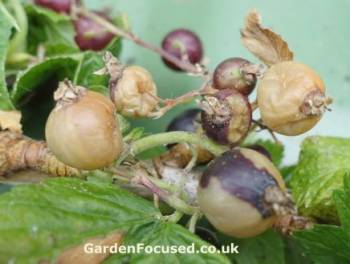
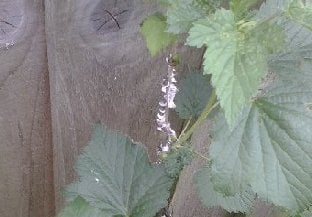
BLACKCURRANT PESTS AND DISEASES
By David Marks
Blackcurrant bushes are generally health plants. However they are sometimes attacked by insects and diseases and this article aims to identify the causes and how to treat them.
BIRDS
As far as size goes, birds are definitely the largest pest to affect blackcurrants. They are attracted to the developing fruit and destroy them completely. All manner of devices have been created to frighten birds and the only one which works is a fruit cage, a physical barrier that stops the birds reaching the fruit.